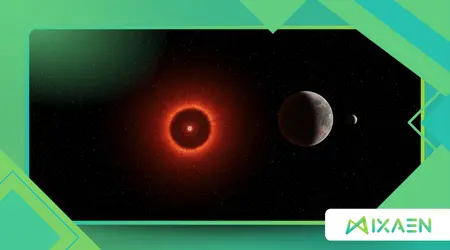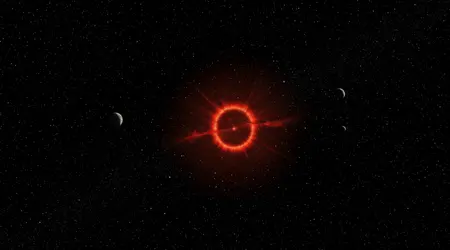Why Red Dwarf Stars Are Promising—and Problematic—for Life

The search for extraterrestrial life increasingly focuses on the seemingly quiet realm of Red Dwarf Stars Are Promising and Problematic for Life.
Anúncios
These diminutive, cool stars, classified as M-dwarfs, vastly outnumber sun-like G-type stars in the Milky Way, comprising up to 75% of all stars.
Their sheer abundance makes them prime targets for discovering Earth-sized, potentially habitable exoplanets. Yet, these cosmic mini-suns present a complex paradox. What they offer in longevity and abundance, they take back in terms of intense, sudden astrophysical violence.
This analysis dives into the heart of this paradox, exploring the compelling reasons for optimism the long lifespans and tightly packed habitable zones and the brutal obstacles tidal locking and destructive stellar flares that challenge the persistence of life.
Understanding these dynamics is crucial to properly interpreting the next wave of discoveries from instruments like the James Webb Space Telescope.
Anúncios
The Compelling Promise: Abundance and Longevity
The two most powerful arguments for searching for life around M-dwarfs are directly tied to their basic stellar characteristics: their sheer numbers and their staggering lifespan.
The Galactic Dominance Factor
Red dwarfs are the demographic kings of the galaxy. Conservatively, there are at least three times as many M-dwarfs as there are sun-like stars. This abundance automatically increases the statistical probability of finding exoplanets within their habitable zones (HZs).
The sheer volume of these systems drastically improves the odds of discovering a habitable world nearby. Systems like TRAPPIST-1, orbiting a red dwarf just 40 light-years away, vividly illustrate this density, showing multiple Earth-sized worlds within one system. This galactic frequency is the strongest evidence that Red Dwarf Stars Are Promising and Problematic for Life.
Furthermore, M-dwarfs are dim. Their small size and low luminosity make detecting the dimming effect of orbiting planets (the transit method) much easier than with brighter, larger stars. Detection is simplified, accelerating the census of potentially habitable worlds.
++ Frozen water around young sun-like stars: A sign of planet formation and potential habitability
Deep Time and Biological Endurance
Longevity is arguably the single greatest advantage M-dwarf systems offer for life. A sun-like star, like ours, lives for about 10 billion years. In contrast, red dwarfs burn their fuel so slowly that their lifespans can extend for trillions of years far exceeding the current age of the universe.
This incredible timescale provides biology with an unprecedented window for evolution. Life on Earth took nearly 4 billion years to evolve beyond single-celled organisms.
The enormous timeline of an M-dwarf system provides countless evolutionary opportunities, potentially allowing complex life to develop over eons. Time is the ultimate crucible for biological complexity.
The promise of deep time suggests that even if early planetary conditions are harsh, the sheer duration of the M-dwarf’s stable burning phase could allow life to survive and adapt. This marathon stability is the most hopeful factor in the equation: Red Dwarf Stars Are Promising and Problematic for Life.

The Problematic Reality: The Habitable Zone’s Cost
To receive enough warmth from the dim red dwarf, planets must orbit extremely close to their star. While this proximity creates a habitable zone (HZ) where liquid water can exist, it introduces devastating physical challenges.
The Curse of Tidal Locking
Because the M-dwarf habitable zone is so close often closer than Mercury is to our Sun planets within it are highly susceptible to tidal locking. This means the planet’s rotation period matches its orbital period.
Also read: TWA-7b: The young Saturn-mass exoplanet was directly photographed
The Eyeball Planet Dilemma
A tidally locked planet has one side perpetually facing the star (the “dayside”) and one side perpetually facing away (the “nightside”). The dayside bakes under constant, dim red light, while the nightside plunges into eternal, freezing darkness.
This configuration creates extreme atmospheric pressure differences, potentially leading to massive, planet-wide winds that carry atmospheric moisture to the nightside, freezing it out into a permanent glacier.
Such a climate imbalance makes maintaining global liquid water the fundamental requirement for life incredibly challenging. Scientists theorize a massive ocean might be required to redistribute heat effectively, creating an “eyeball planet” with a liquid center ring.
This severe climate differential is a dominant reason why Red Dwarf Stars Are Promising and Problematic for Life. Habitability requires finding a mechanism to overcome this thermal dichotomy.
Read more: The James Webb Telescope’s Hunt for Alien Atmospheres
Atmospheric Erosion and Magnetic Fields
The intense proximity also means the planet’s atmosphere is constantly bombarded by the stellar wind streams of charged particles emanating from the star. Without a robust, global magnetic field, this stellar wind can quickly strip a planet of its atmosphere and, consequently, its water.
If an M-dwarf planet cannot sustain a powerful, persistent magnetic field (a magnetosphere), its atmospheric gases will escape into space over a relatively short geological timescale.
Any life that develops would be quickly suffocated or desiccated, regardless of the star’s billions of years of longevity.
The Flare Factor: Stellar Violenc
The single greatest threat to life around red dwarfs comes not from the star’s usual dimness, but from its periodic, intense violence: stellar flares.
The UV and X-Ray Bombshells
Despite their dim visible light output, M-dwarfs are prone to extremely powerful, unpredictable flares, particularly when they are young and active. These flares can be hundreds to thousands of times more energetic than the most powerful flares emitted by our Sun.
The Sterilizing Radiation Blast
These mega-flares bathe nearby planets in massive doses of X-ray and ultraviolet (UV) radiation. Even if a planet manages to retain an atmosphere, these radiation bursts could repeatedly sterilize the surface, destroying complex organic molecules and making the emergence of life exceedingly difficult.
Any surface life would require remarkable defenses perhaps living deep underground or underwater to survive these recurrent sterilization events. The constant threat of a massive flare fundamentally dictates whether Red Dwarf Stars Are Promising and Problematic for Life can host complex biospheres.
Research Data: A 2024 observational study published in The Astrophysical Journal tracking dozens of nearby M-dwarfs found that approximately 40% of observed M-dwarfs experienced at least one “super-flare” event a flare exceeding the Sun’s maximum observed output by or more within a 12-month period. This demonstrates the constant, hostile radiation environment.
Mitigation and Adaptation: Finding Life’s Loophole
If life exists in these harsh environments, it must have evolved specific, remarkable adaptations to overcome the M-dwarf’s inherent problems.
The Water World Solution
The most common scientific hypothesis for sustaining habitability under tidal locking is a Water World scenario. A planet fully covered by a deep, global ocean could efficiently redistribute heat via ocean currents.
The constant circulation would prevent the nightside from freezing solid and the dayside from boiling, maintaining a narrow temperature band conducive to liquid water life.
This deep, global ocean would also provide excellent shielding from stellar flares and radiation. This environment shifts the question of Red Dwarf Stars Are Promising and Problematic for Life to one of adaptation.
Analogia: Life adapting to a tidally locked M-dwarf planet is like a ship navigating a world where the sun never moves. The “habitable zone” isn’t a global region but a narrow, perpetually twilight border on the ocean between the scorching heat and the endless ice. Survival is a constant battle against the extremes.
Subsurface or Chemosynthetic Life
Perhaps the best bet for life in these systems lies not on the surface, but underground or beneath thick ice sheets.
Similar to extremophiles found near deep-sea hydrothermal vents on Earth, life on an M-dwarf planet might rely on chemosynthesis deriving energy from geothermal or chemical reactions rather than photosynthesis.
The rock and water would provide a natural radiation shield, allowing evolution to proceed uninterrupted by surface flares. This concept suggests life could be far more abundant than we expect, yet tragically difficult to detect remotely.
Summary of M-Dwarf Challenges and Solutions
| Characteristic | Challenge to Life | Biological/Planetary Mitigation | Why Red Dwarf Stars Are Promising—and Problematic—for Life |
| Close Orbit (HZ) | Tidal Locking (Extreme Heat/Cold) | Deep, Global Ocean for Heat Redistribution (Water World) | Problematic: Creates catastrophic climate instability. |
| Stellar Activity | Frequent, Powerful Stellar Flares (X-Ray/UV) | Subsurface Habitats or Thick, Ozone-Rich Atmosphere | Problematic: High radiation risk, potentially sterilizing the surface. |
| Low Luminosity | Dim light; limited surface photosynthesis. | Life uses Chemosynthesis (deep vents) or adapts to utilize infrared light. | Promising: Low energy output ensures trillions of years of stability. |
| Abundance | Statistical Improbability of Life Here. | Sheer quantity of M-dwarf systems (75% of Galaxy). | Promising: Highest probability of finding an Earth-sized world. |
Conclusion: A Weighted Wager
The quest to answer whether Red Dwarf Stars Are Promising and Problematic for Life represents a high-stakes scientific wager.
We know these stars host the vast majority of potentially Earth-sized worlds, offering immense longevity for evolution. Yet, the price of that longevity is paid in atmospheric erosion, tidal locking, and relentless radiation flares.
If life thrives there, it will be tough, subterranean, or aquatic, fundamentally different from the familiar life on Earth’s surface. The next generation of telescopes will soon reveal whether the life-killing effects of flares and tidal locking are absolute barriers or merely evolutionary hurdles.
Which force longevity or violence will ultimately win the cosmic debate? Share your thoughts: Do you believe life is thriving underground on these worlds, or are the flares too great a barrier?
Frequently Asked Questions (FAQs)
Q: Why is tidal locking such a major problem for life?
A: Tidal locking creates a huge thermal imbalance: one side is constantly hot, and the other is constantly freezing. This drives extreme winds and traps the planet’s water vapor and atmosphere on the dark, frozen side, essentially eliminating the conditions for widespread liquid water on the surface.
Q: Can M-dwarf planets develop an ozone layer to protect against flares?
A: It’s highly debated. Stellar flares initially strip away the atmosphere. If the planet manages to retain a substantial atmosphere despite the flares, it might produce an ozone layer.
However, each subsequent flare could destroy that ozone layer repeatedly, leaving surface life perpetually vulnerable.
Q: How close is the habitable zone around a typical red dwarf star?
A: The habitable zone is extremely close often to
Astronomical Units (AU), meaning a planet might complete an orbit in just a few Earth days.
This close proximity is why the tidal locking effect is so strong, illustrating why Red Dwarf Stars Are Promising and Problematic for Life due to the associated proximity effects.
